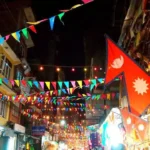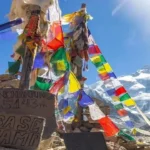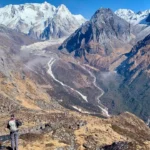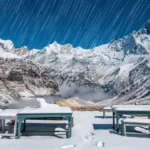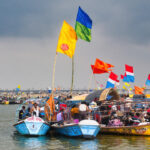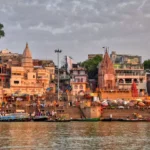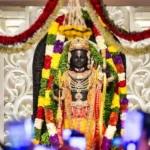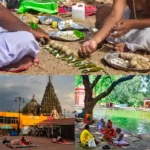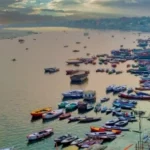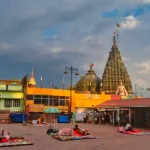The Journey to Muktinath: A Pilgrimage of Awe and Challenge
Reaching Muktinath Temple is an experience in itself, offering breathtaking landscapes, cultural immersion, and a test of endurance. The journey, often undertaken by pilgrims and trekkers, is as significant as the destination.
Location and Geographical Features
Muktinath is located in the Mustang district of Nepal, a trans-Himalayan region known for its stark, arid landscapes, deep gorges, and dramatic mountain views. It lies near the base of the formidable Thorong La Pass, a high mountain pass that is part of the famous Annapurna Circuit trekking route. The region is characterised by dry, windswept cliffs, unique geological formations, and panoramic vistas of towering peaks such as the Annapurna and Dhaulagiri ranges. The Kali Gandaki River, renowned for its Shaligram stones, flows through this region, adding to its sacred allure.
How to Reach Muktinath
There are several ways to reach Muktinath, catering to different levels of adventure and time constraints:
-
By Flight and Drive: This is the quickest and most popular option for many pilgrims.
- Kathmandu/Pokhara to Jomsom Flight: Regular flights operate from Kathmandu (via Pokhara) to Jomsom, the district headquarters of Mustang. The flight from Pokhara to Jomsom is a short and scenic 15-20 minute journey through the Kali Gandaki Gorge, offering spectacular views. Flights generally operate only in the mornings due to strong winds later in the day.
- Jomsom to Muktinath: From Jomsom, Muktinath is approximately 20-25 kilometres away. Pilgrims can hire a local jeep or bus (about a 1.5 to 2-hour drive) to Ranipauwa, the last motorable point near the temple. From Ranipauwa, it’s a relatively easy 15-20 minute walk uphill to the temple complex. Horses or doli (palanquin) services are also available for those unable to walk.
-
By Road (Jeep/Bus):
- Kathmandu/Pokhara to Muktinath: With improving road infrastructure, it is now possible to travel by jeep or bus directly from Kathmandu or Pokhara to Muktinath. This is a longer journey, typically taking 7-10 hours from Pokhara and significantly more from Kathmandu, depending on road conditions. The road can be challenging and bumpy in parts, but it offers a continuous scenic drive through diverse landscapes.
-
Trekking: For the adventurous and those seeking a deeper spiritual and physical experience, trekking to Muktinath is an excellent option.
- Jomsom-Muktinath Trek: This is a relatively easy and popular short trek. From Jomsom, the trail gradually ascends through villages like Kagbeni (a medieval-looking village and checkpoint for Upper Mustang) and Jharkot before reaching Ranipauwa. The trek offers opportunities to interact with local Thakali communities and experience the unique trans-Himalayan culture.
- Annapurna Circuit Trek: Muktinath lies on the western side of the Thorong La Pass, making it a natural stop for trekkers completing the Annapurna Circuit. After crossing the challenging Thorong La Pass, trekkers descend to Muktinath, finding spiritual solace after their arduous journey.

Best Time to Visit
The ideal time to visit Muktinath Temple is during the spring (March to May) and autumn (September to November) months. During these periods, the weather is generally pleasant, with clear skies, comfortable temperatures, and excellent visibility of the surrounding snow-capped mountains. The trails are also more accessible, and the overall travel experience is more comfortable.
- Spring (March-May): The rhododendrons bloom, and the weather is mild, making for pleasant trekking and sightseeing.
- Autumn (September-November): Offers crisp, clear air and stable weather, providing spectacular mountain views. This is often considered the peak season for trekking and pilgrimage.
Winter (December-February) sees very cold temperatures and heavy snowfall, making access difficult, especially by road and flight. Monsoon (June-August) brings heavy rainfall, which can lead to landslides and make roads and trails challenging. While the temple remains open year-round, these off-seasons require careful planning and preparedness.
Accommodation
Accommodation options are available in Jomsom, Kagbeni, and Ranipauwa (near the temple). These range from basic guesthouses and lodges to some more comfortable hotels, catering primarily to pilgrims and trekkers. It is advisable to book accommodation in advance, especially during peak seasons. Ranipauwa also has traditional Dharmashalas (rest houses) that have historically provided free lodging and meals to pilgrims, maintaining a centuries-old tradition of hospitality.
Rituals and Experience at Muktinath: A Transformative Journey
The pilgrimage to Muktinath is not just a physical journey but a profound spiritual experience, filled with rituals, prayers, and deep introspection.
Performing the Rituals
Upon reaching Ranipauwa, pilgrims typically prepare for their visit to the temple.
- The 108 Muktidhara Bath: This is the most iconic ritual. Devotees brave the icy cold water from the 108 spouts, often taking a quick dip under each one. Despite the chilling temperature, pilgrims believe this act is essential for spiritual purification and the washing away of sins.
- Mukti Kunda Dips: After the spouts, pilgrims often take a bath in the two sacred ponds (Mukti Kunda) located in front of the temple.
- Darshan and Pooja: Inside the main Mukti Narayana Temple, devotees offer prayers (pooja) and seek darshan (sight of the deity) of Lord Vishnu. The temple has a golden idol of Vishnu as Shri Mukti Narayana, flanked by idols of Goddess Lakshmi and other deities.
- Jwala Mai Temple Visit: A visit to the nearby Jwala Mai Temple is crucial to witness the eternal flame. Here, pilgrims pay homage to the elements and the miraculous convergence of fire and water.
- Collecting Shaligrams: Many pilgrims collect Shaligram stones from the Kali Gandaki River as sacred mementoes and for worship back home.
- Buddhist Offerings: Buddhist pilgrims perform circumambulations (kora) around the temple and light butter lamps, offering prayers and meditating in the serene environment. The Buddhist monastery near the temple provides a peaceful space for meditation and learning about Tibetan Buddhist practices.

The Spiritual Experience
The unique atmosphere of Muktinath, with its high-altitude grandeur, the sound of rushing water, the sight of the eternal flame, and the confluence of Hindu and Buddhist devotees, creates a truly transformative experience. Many pilgrims report a profound sense of peace, purification, and inner renewal after their visit. The arduous journey itself often contributes to this feeling of accomplishment and spiritual growth.
The air at such high altitudes is incredibly pure, and the serene ambience fosters an environment conducive to meditation and self-reflection. The panoramic views of the Himalayas serve as a constant reminder of the vastness and majesty of the divine, further deepening the spiritual connection.
Legends and Myths: Stories That Shape Devotion
Muktinath is rich with legends and myths that have been passed down through generations, adding layers of spiritual depth and cultural significance to the site.
- The Curse and Redemption of Lord Vishnu: As mentioned, one popular Hindu myth relates to Lord Vishnu taking the form of a Shaligram stone to atone for a curse by Goddess Lakshmi. This narrative underscores the purifying power of Muktinath and its association with Vishnu’s divine grace.
- Sati Devi’s Organs: Another Hindu legend connects Muktinath to the Sati Peeths. It is believed that when Lord Shiva grieved over the death of his beloved wife Sati, her body parts fell at various locations, creating sacred Shakti Peeths. While not a primary Sati Peeth, some traditions associate the region with parts of Sati’s body, further sanctifying the land.
- Meditation of Sages: Ancient texts speak of several sages who performed intense penance at Muktinath to seek liberation. Pleased with their devotion, Lord Vishnu appeared before them and granted them moksha, solidifying the temple’s reputation as a “place of salvation.”
- Shiva and Parvati at Muktinath: A lesser-known legend describes Lord Shiva and Parvati’s journey to Muktinath. Parvati, curious about Vishnu’s Shaligram form, collected many stones from the Kali Gandaki. Shiva playfully warned her that collecting too many would make her unable to carry them, symbolising that true salvation requires a focused and balanced mind, not merely material acquisition.
These interwoven narratives from both Hindu and Buddhist traditions highlight the universality of faith and the deep spiritual energy that permeates Muktinath.

Environmental and Cultural Considerations
As a sacred site located within the Annapurna Conservation Area, Muktinath also presents important environmental and cultural considerations.
Environmental Impact
The increasing number of pilgrims and trekkers to Muktinath necessitates mindful tourism practices.
- Waste Management: Proper disposal of waste is crucial to preserve the pristine Himalayan environment. Visitors are encouraged to practice “Leave No Trace” principles.
- Resource Conservation: Being mindful of water and energy consumption, especially in such a remote area, is important.
- Altitude Acclimatisation: Due to the high altitude, visitors need to be aware of the risks of altitude sickness. Proper acclimatisation, staying hydrated, and avoiding alcohol are crucial for a safe journey.
Cultural Preservation
The Mustang region is home to the Thakali people, an indigenous ethnic group with a rich cultural heritage. Their unique traditions, language, and architecture contribute significantly to the cultural fabric of the area.
- Respecting Local Customs: Visitors should dress modestly and respect local religious practices and customs.
- Supporting Local Economy: Engaging with local businesses, guesthouses, and guides helps support the livelihoods of the Thakali community.
- Permits: Visitors to Muktinath, being within the Annapurna Conservation Area, require an Annapurna Conservation Area Permit (ACAP) and a Trekkers’ Information Management System (TIMS) card. These permits contribute to the conservation efforts and regulation of tourism in the region.
The development of infrastructure, including roads, has significantly impacted the traditional trekking routes and the livelihoods of villages that once served as vital stops for trekkers. Efforts are being made to balance modernisation with the preservation of cultural heritage and the sustainability of local economies. New trekking routes are also being planned to connect key heritage sites around Muktinath, aiming to enrich the cultural and spiritual experience for visitors.

Economic Impact on Local Communities
The pilgrimage to Muktinath has a significant economic impact on the local communities in the Mustang region.
- Tourism as a Livelihood: Tourism, driven by both religious pilgrims and adventure trekkers, is a primary source of income for many families. Guesthouses, restaurants, shops selling religious artefacts, and guiding services all thrive due to the influx of visitors.
- Infrastructure Development: The increase in tourism has led to the development of better roads, accommodation facilities, and communication networks, improving connectivity and access to essential services for locals.
- Challenges of Modernisation: However, the rapid development, particularly the construction of roads, has also presented challenges. Some traditional trekking trails have been bypassed, affecting the income of villages that relied heavily on trekkers. There’s a delicate balance to be maintained between facilitating access and preserving the region’s unique cultural and natural integrity.
- Conservation Efforts: Revenue from permits and tourism is vital for conservation efforts within the Annapurna Conservation Area, aiming to protect the fragile ecosystem and cultural heritage of the region.









